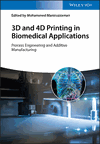Recent Innovations in Additive Manufacturing Across Industries: 3D Printed Products and FDA's Perspectives
Summary
Three-dimensional (3D) printing, also known as additive manufacturing, is a process in which layers of material are combined to produce a three-dimensional object. This chapter explains the methods currently employed in the industry today to fabricate 3D objects via 3D printing followed by regulatory aspects. It presents a brief introduction to the most commonly used forms of 3D printing with a particular focus on the practical applications. The fused deposition modeling works by depositing layers of material filament via extrusion through a nozzle onto a flat printing bed. Stereolithography and digital light processing use photopolymerization by light to cure liquid resin forming polymers. Selective laser sintering forms 3D objects in a chamber of powder where the print layers are fused together by the heat from a high-powered laser. Medical devices manufactured by 3D printing technology, such as medical objects produced by any other technology, are subject to regulation by the US Food and Drug Administration.



